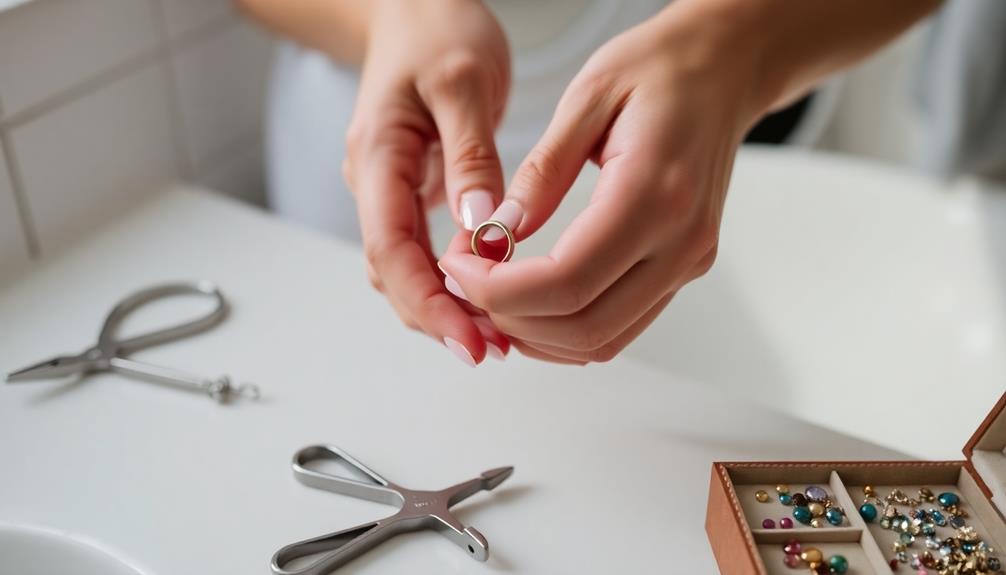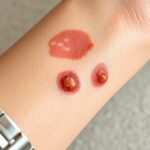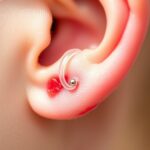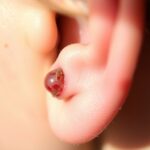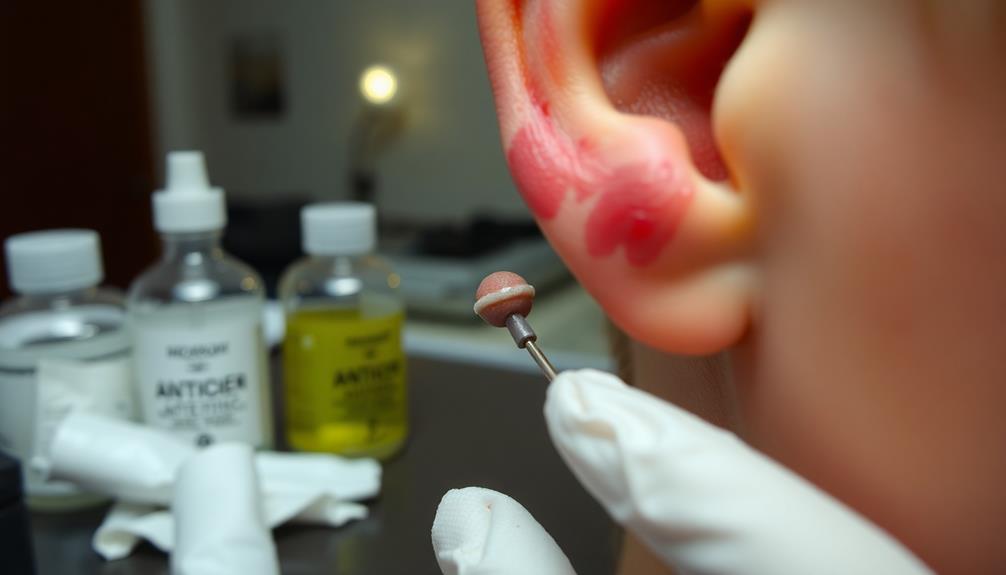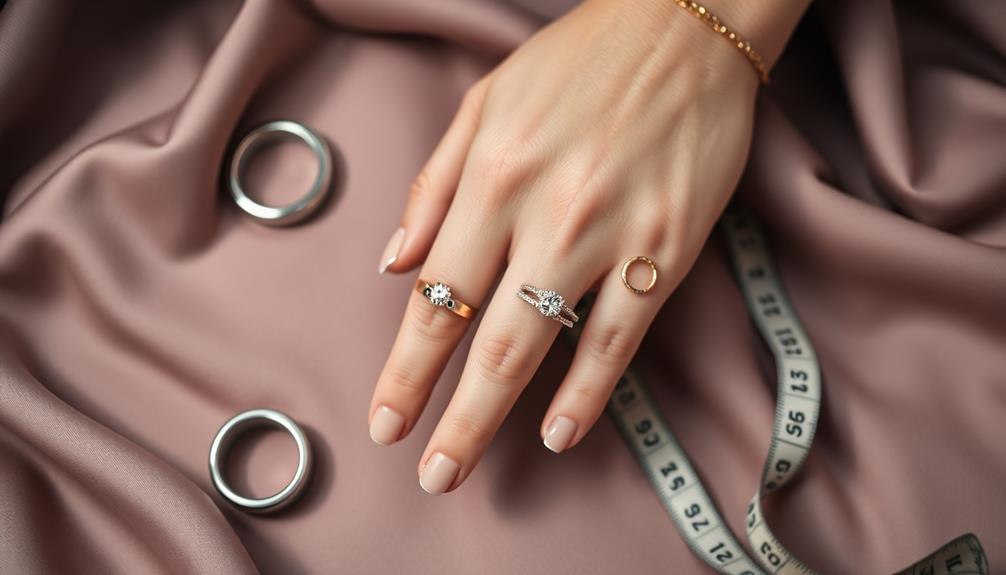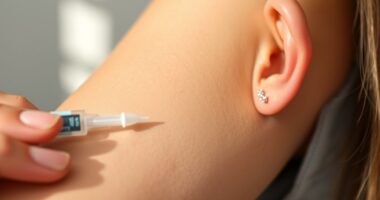If you're experiencing piercing allergies, you're not alone—about 18% of North Americans face similar issues. Symptoms often include redness, swelling, and itching at the piercing site, and they can arise from metals like nickel. To prevent reactions, choose hypoallergenic materials such as surgical stainless steel or titanium. Proper aftercare is crucial; regularly clean your piercing and monitor for any adverse signs. If symptoms persist or worsen, it's important to consult a healthcare professional for advice. Understanding these factors will help you manage your allergies better and make informed choices about your body jewelry.
Key Takeaways
- Allergic reactions to piercings are commonly caused by nickel, affecting about 18% of North Americans and leading to symptoms like redness and swelling.
- Symptoms may appear within 24 to 48 hours and can include itching, discharge, and systemic reactions like hives.
- Hypoallergenic materials, such as titanium and surgical stainless steel, are recommended to prevent allergic reactions and infections.
- Effective treatments include over-the-counter antihistamines and topical corticosteroids; seek medical help for severe or persistent symptoms.
- Proper aftercare, including regular cleaning and monitoring for reactions, is crucial for safe healing and minimizing allergic responses.
Understanding Piercing Allergies
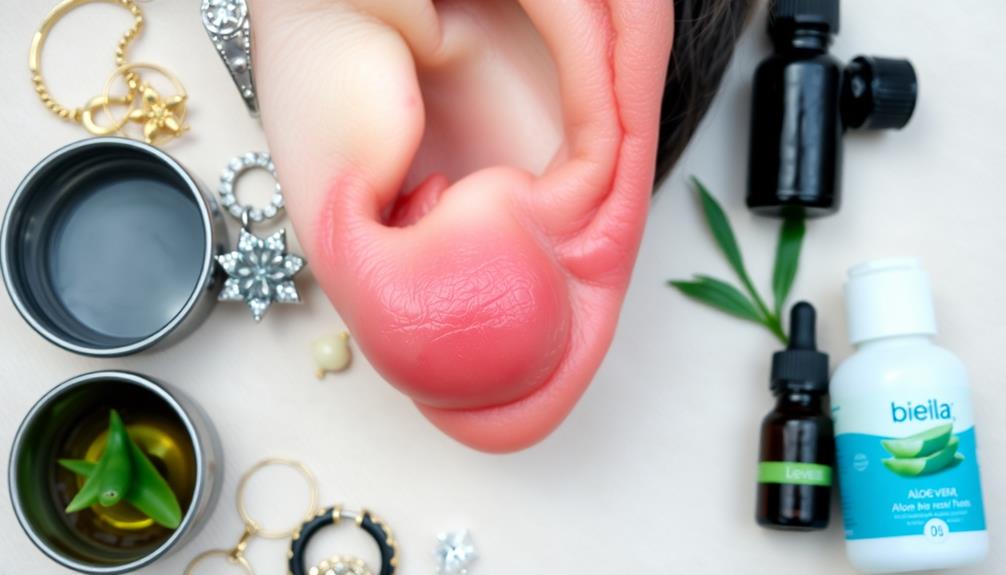
When you get a piercing, it's important to understand the potential for allergic reactions. Many people develop allergies to certain metals, especially nickel, which is commonly found in jewelry. Approximately 18% of North Americans are allergic to nickel, leading to contact dermatitis when it touches the skin. This can result in symptoms like redness, swelling, and itching around the piercing site.
You might experience these symptoms within 24 to 48 hours after exposure, but sometimes, they can take up to two weeks to appear. To prevent these reactions, choose hypoallergenic materials for your jewelry, such as surgical stainless steel or titanium. These metals are less likely to trigger an allergy and can help you enjoy your piercing without discomfort.
Proper aftercare is also important for prevention. Keep the area clean and follow your piercer's advice to minimize irritation and infection risks.
If you suspect you're having an allergic reaction, consult a healthcare professional. They'll likely perform a physical examination and may recommend patch testing to identify specific metal allergens responsible for your reaction. Understanding these factors can make a significant difference in your piercing experience.
Common Symptoms of Allergic Reactions
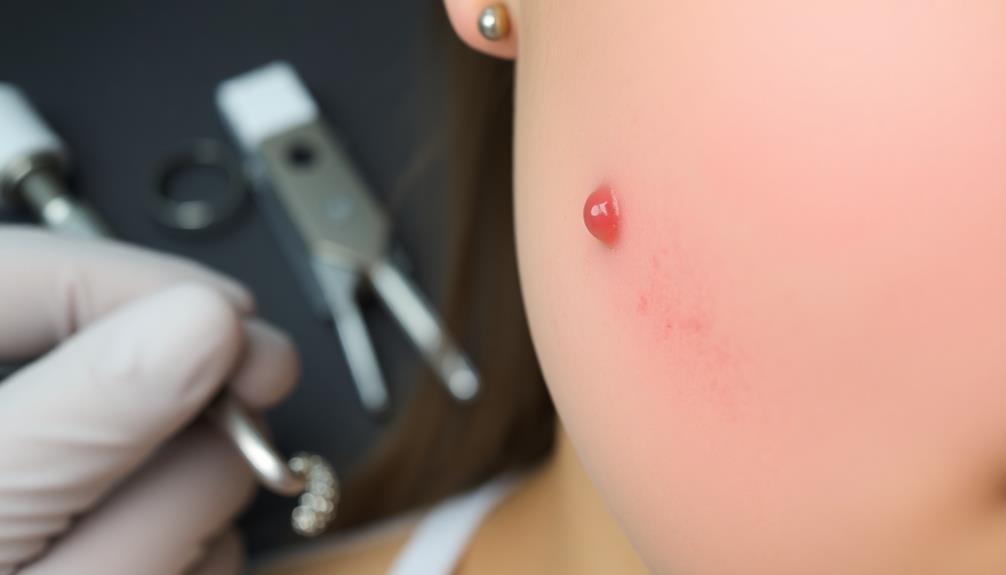
When you get a body piercing, it's important to watch for signs of an allergic reaction.
Common symptoms include redness and swelling, persistent itching, and sometimes discharge from the area.
If you notice any of these changes, it's essential to address them promptly to prevent further complications.
Redness and Swelling
Redness and swelling at the piercing site often signal an allergic reaction, typically surfacing within 24 to 48 hours after exposure to common allergens like nickel, cobalt, or chromium found in body jewelry.
When your immune system perceives these metals as threats, it triggers an inflammatory response, leading to redness and swelling. This condition, known as allergic contact dermatitis, can result in persistent symptoms that might indicate an ongoing allergic response or even an infection, which requires prompt medical evaluation.
Awareness of gaslighting tactics can also be beneficial for those facing emotional challenges during recovery, as the stress from allergies can compound existing emotional issues.
If you experience significant redness and swelling, it can cause discomfort and make wearing your jewelry challenging. In severe cases, systemic symptoms such as hives or rashes might appear, reflecting heightened sensitivity to metals.
To manage these symptoms effectively, it's essential to remove the offending jewelry immediately. Applying topical corticosteroids can help alleviate the severe redness and swelling associated with the allergic reaction.
Maintaining a clean piercing can also reduce the risk of complications. Always consult a healthcare professional if symptoms persist, as they can guide you on the best course of action to guarantee your well-being.
Itching and Rashes
Many people experience itching and rashes as common symptoms of allergic reactions to body piercings. When you're allergic, you might notice redness, swelling, or discomfort around the pierced area, typically appearing within 24 to 48 hours after exposure to allergens like nickel.
With approximately 18% of North Americans allergic to nickel, it's a significant factor contributing to these symptoms. Additionally, certain foods can impact skin reactions, so it's wise to monitor your diet for potential irritants dangers of raisins for dogs.
Allergic contact dermatitis can lead to severe itching and dry patches, sometimes even blisters at the piercing site. In some cases, you might also notice rashes on other parts of your body, signaling a broader immune response to metal allergens.
Delayed reactions can occur, surfacing up to two weeks later, which can make it tricky to pinpoint the cause of your symptoms.
If you're experiencing persistent itching or rashes, it's crucial to identify the triggers. Switching to hypoallergenic jewelry made from materials like titanium or surgical stainless steel can help alleviate these symptoms.
Discharge and Infection
Discharge from a pierced area often signals an allergic reaction, and it's vital to pay attention to its characteristics. You might notice symptoms like redness and swelling around the piercing site, which can indicate that your body is reacting to the jewelry material.
However, not all discharge is created equal. Here are three key points to keep in mind:
- If the discharge is clear or white, it might be a sign of an allergic reaction.
- Yellow or green discharge often suggests an infection, which requires prompt medical evaluation.
- Persistent itching can lead to scratching, increasing the risk of infection at the piercing site.
You should also watch for other symptoms of infection, such as increased warmth, pus, and pain. These can overlap with allergic reactions, making diagnosis tricky.
If you experience severe swelling, hives, or systemic symptoms like fever, don't hesitate to seek medical attention. It's important to address these issues early to avoid complications.
Keeping a close eye on the discharge and overall condition of your piercing can help you manage any allergic reactions or infections effectively.
Identifying the Causes
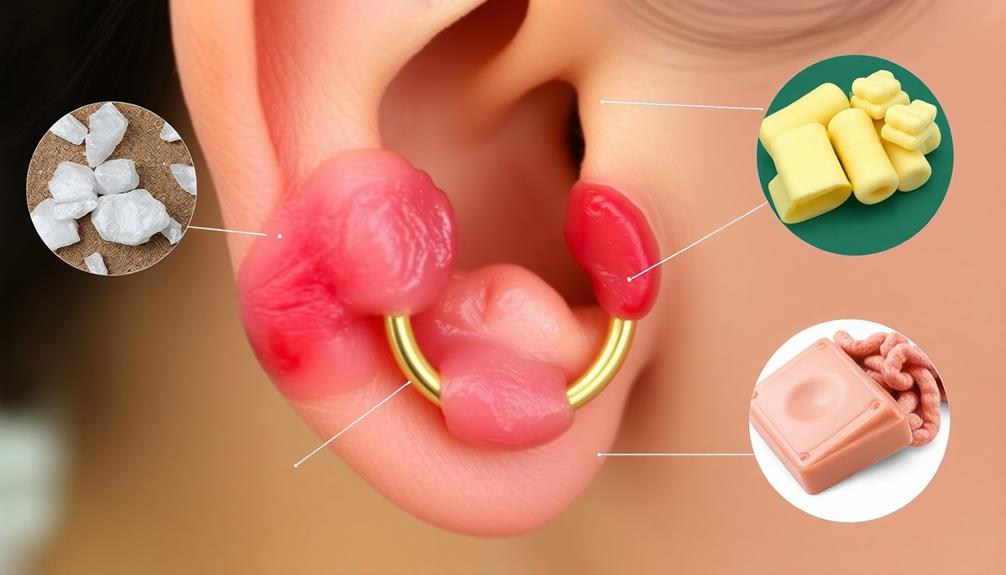
Identifying the causes of piercing allergies can be essential for anyone considering body jewelry. One of the most common culprits is a nickel allergy, which affects up to 20% of the population. When you wear jewelry made from nickel, cobalt, or chromium, your immune response might trigger allergic reactions, leading to discomfort and irritation.
Understanding trust issues with boyfriends can help highlight how communication plays a role in managing body jewelry choices and potential reactions.
Symptoms of an allergic reaction can take time to appear, sometimes showing up 24 to 48 hours or even weeks after exposure to specific allergens. If you have a history of metal allergies or multiple piercings, you're at a higher risk for developing these reactions.
To pinpoint the exact cause of your allergy, a patch test can be incredibly helpful, allowing you to identify which metals provoke your immune response. Once you know your specific allergens, you can make informed choices about the types of jewelry you wear.
Opting for hypoallergenic materials, like titanium or surgical stainless steel, is one way of reducing the risk of allergic reactions. Being proactive about understanding the materials in your body jewelry will help you enjoy your piercings without the worry of allergic complications.
Diagnosis and Testing Methods

When you suspect a piercing allergy, the first step is often a physical examination to check for symptoms like redness or swelling.
If those signs are present, your doctor might recommend patch testing to pinpoint specific metal allergens.
This process helps identify reactions to common offenders like nickel and cobalt, guiding your next steps for treatment.
Physical Examination Techniques
A thorough physical examination is vital for diagnosing piercing allergies effectively. During this process, your dermatologist will assess the affected area for visual symptoms like redness, swelling, and discharge that may indicate allergic reactions or infections.
It's important to understand your medical history as well, as previous metal exposure and known metal allergies can greatly aid in the diagnostic process.
Here are three key steps in the physical examination techniques for piercing allergies:
- Assess Symptoms: Your doctor will closely examine the symptoms you're experiencing, looking for signs of allergic reactions.
- Review Medical History: A detailed discussion about your past experiences with metal allergens helps identify potential triggers.
- Plan Follow-Up Consultations: If necessary, your dermatologist may schedule follow-up appointments to confirm the diagnosis and monitor your response to treatment or avoidance strategies.
These steps guarantee a thorough evaluation, setting the stage for effective solutions.
Patch Testing Procedure
After evaluating your symptoms and reviewing your medical history, the next step in diagnosing piercing allergies is patch testing. This procedure involves applying small amounts of suspected allergens, like nickel, to your skin. The patches are then covered with adhesive for 48 hours to monitor any allergic reactions.
Once the 48 hours are up, the patches are removed, and your skin is assessed for any signs of irritation, which might present as redness, swelling, or rash.
It's significant to mention that some reactions can be delayed, so the skin response is evaluated again 72 hours after the patches are taken off.
Patch testing is a standard diagnostic tool for identifying contact dermatitis caused by metals and other allergens typically found in body jewelry. Common allergens tested include nickel, cobalt, and chromium.
By pinpointing which specific allergens trigger your allergic reactions, you'll be better equipped to make informed choices about your body jewelry and avoid materials that could cause further irritation.
This process is essential in managing and understanding your piercing allergies effectively.
Effective Treatment Options
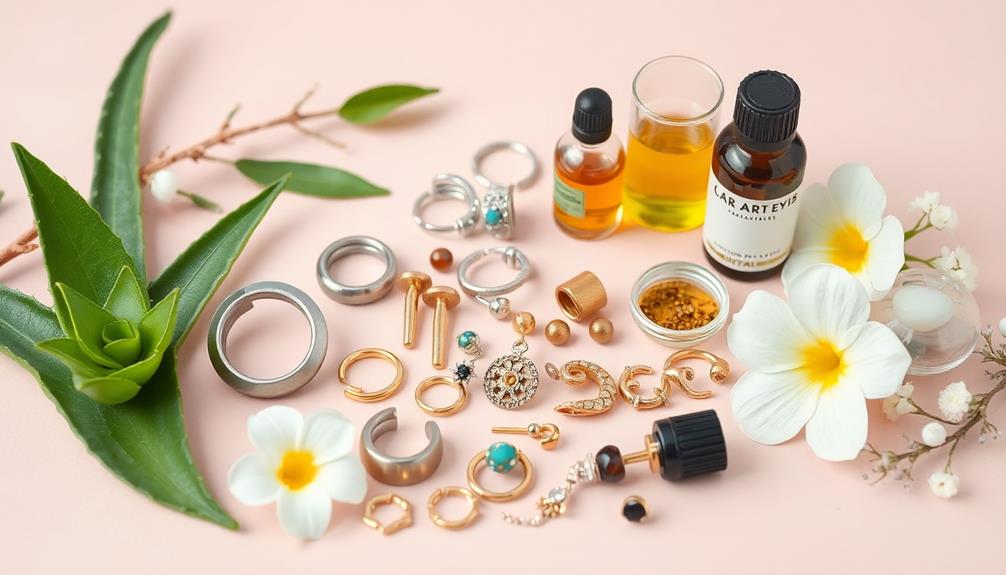
Effective treatment options are fundamental for managing piercing allergies, as they can help relieve uncomfortable symptoms quickly. If you're experiencing allergic reactions, like itching and swelling, it's important to understand the potential impact on mental health, similar to the effects seen in victims of narcissistic abuse, which can also lead to significant emotional distress.
Here are three effective treatment options to take into account:
- Over-the-Counter Antihistamines: These can alleviate mild allergic symptoms, providing immediate relief from discomfort.
- Topical Corticosteroids: If you notice more severe symptoms of nickel allergy, these prescriptions can reduce inflammation and manage allergic dermatitis effectively.
- Medical Help: For persistent allergic reactions, it's important to remove the piercing and consult a healthcare professional for further evaluation. Allergy testing may be necessary to identify triggers and guide future choices.
While hypoallergenic materials can minimize the risk of future allergies, some individuals may require more advanced options, like immunotherapy. This treatment, which includes allergy shots, aims for long-term management of metal allergies but needs professional supervision.
Remember, if you experience severe allergic reactions, seek immediate medical attention. Treatments like Benadryl or NSAIDs may be administered to help your immune systems respond better.
Prioritizing proper aftercare will also support your healing process and reduce the likelihood of future allergic reactions.
Management and Aftercare Tips

Managing piercing allergies effectively relies on diligent aftercare practices. Start by choosing hypoallergenic materials like titanium or surgical-grade stainless steel for your jewelry, as they minimize exposure to nickel and other allergens.
Maintaining proper hygiene is vital; clean the piercing site regularly with saline solution and avoid touching it with unwashed hands to prevent infection and irritation.
Make it a habit to monitor the piercing for early signs of allergic reactions, such as redness, swelling, or itching. If you notice any persistent symptoms, consult a healthcare provider promptly.
Following the aftercare instructions provided by your professional piercer is important. This includes avoiding swimming in pools or hot tubs until your piercing is fully healed to reduce the risk of complications.
If you experience persistent allergic reactions, consider removing the jewelry and seeking professional medical advice. Treatment options may include topical corticosteroids or antihistamines to alleviate your symptoms.
Preventing Allergic Reactions
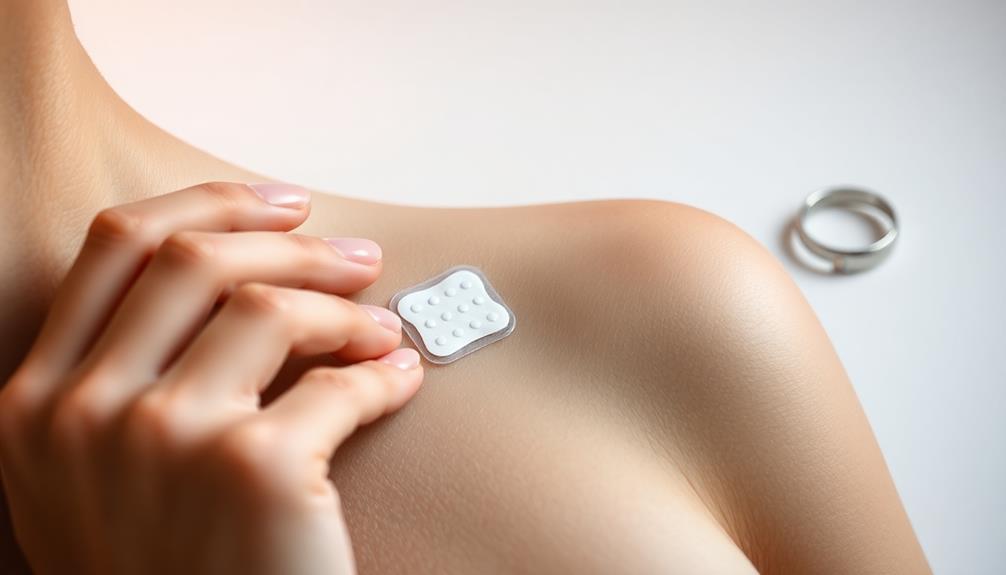
To prevent allergic reactions from piercings, you should choose hypoallergenic jewelry made from materials like titanium or surgical-grade stainless steel.
It's also essential to follow proper aftercare techniques, including regular cleaning of the piercing site.
Hypoallergenic Jewelry Options
When it comes to preventing allergic reactions, choosing hypoallergenic jewelry is essential for anyone with sensitive skin.
You'll want to look for materials specifically designed to minimize irritation, similar to how air purifiers maintain efficiency by filtering out allergens in the environment.
Here are three great options:
- Surgical Stainless Steel: This material contains low levels of nickel and is less likely to cause allergic reactions, making it an excellent choice for everyday wear.
- Titanium: Known for its strength and biocompatibility, titanium is completely nickel-free, reducing your risk of exposure to common allergens.
- Gold Options: Opt for 14k or 18k gold that's labeled as nickel-free to guarantee you're minimizing allergy risks.
When shopping, always look for jewelry specifically labeled as "hypoallergenic," guaranteeing it's been tested against common allergens like nickel and cobalt.
Additionally, avoid jewelry made from base metals or alloys that often contain nickel, like brass.
Regularly cleaning your hypoallergenic jewelry will help maintain its integrity and further reduce the risk of irritation or allergic reactions at the piercing site.
Proper Aftercare Techniques
Choosing hypoallergenic jewelry is just the first step in guaranteeing your piercings remain irritation-free; proper aftercare techniques play a fundamental role as well. To minimize the risk of allergic reactions, follow these essential aftercare tips:
| Step | Action | Purpose |
|---|---|---|
| Clean the area | Use saline solution or gentle antiseptic | Prevents infection and irritation |
| Avoid touching | Keep hands clean and avoid touching the piercing | Reduces bacteria introduction |
| Monitor regularly | Check for redness, swelling, or discharge | Guarantees timely medical consultation if needed |
Keeping the piercing dry is essential. Avoid submerging it in pools or hot tubs, as moisture can cause irritation and potential allergic responses. Regularly changing to hypoallergenic materials, like surgical stainless steel or titanium, can also greatly reduce the risk of allergies.
Should you notice any early signs of complications, don't hesitate to seek medical consultation. Proper aftercare isn't just about maintaining your piercing; it's about guaranteeing your comfort and health throughout the healing process. Taking these steps can help you enjoy your new piercing without worry.
Impact on Sensitive Individuals
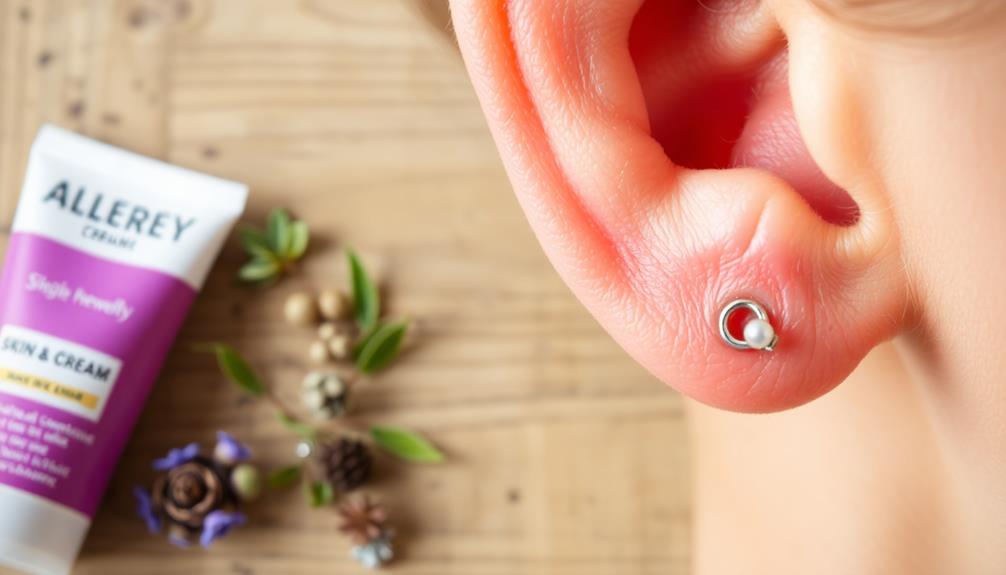
Steering through the world of body piercings can be particularly challenging for sensitive individuals prone to allergic reactions. If you have nickel allergies, you're not alone; around 18% of North Americans share this struggle. Understanding your options is vital for avoiding discomfort and complications.
Here are three key considerations for sensitive individuals:
- Choose Hypoallergenic Materials: Opt for surgical stainless steel or titanium to minimize the risk of allergic reactions. These materials are less likely to trigger symptoms.
- Monitor Symptoms of an Allergic Reaction: Keep an eye out for redness, swelling, or itching at the piercing site. If you notice these symptoms, seek immediate attention to manage the situation effectively.
- Consider Your Immune System: If your immune system is compromised, be aware that you face a higher risk of infections. Proper aftercare is essential to prevent complications.
Choosing Safe Jewelry Materials

Selecting the right jewelry materials is essential for those with sensitive skin or allergies. To minimize the risk of allergic reactions, you should opt for hypoallergenic materials like titanium, surgical-grade stainless steel, or niobium. These metals are less likely to trigger body piercing allergies compared to those containing nickel or other metals.
Additionally, just as chia seeds support digestive health, choosing safe jewelry materials can contribute to overall well-being by preventing skin irritations. When you're considering gold, choose 14k or 18k options for healed piercings, as they usually have lower levels of nickel, making them safer for your sensitive skin.
Avoid jewelry made from plated metals, since the coating can wear off over time, exposing your skin to nickel and other allergens beneath. Be cautious with costume jewelry, which often contains high levels of nickel—a common allergen that can provoke allergic reactions, especially for those with sensitivities.
Before purchasing body jewelry, always inquire about the metal composition. Understanding the materials used can greatly help you in avoiding exposure to potential irritants and guarantee that you're selecting safer options.
When to Seek Medical Help

Your health should always come first when it comes to body piercings. If you suspect you're having an allergic reaction or notice any troubling signs, don't hesitate to seek medical help.
Here's when you should definitely reach out to a healthcare provider:
- Severe Symptoms: If you experience severe swelling, hives, or difficulty breathing, these could signal a serious allergic reaction that needs immediate attention.
- Persistent Issues: If the redness, swelling, or discharge from your piercing site doesn't improve after switching to hypoallergenic materials, it's time to consult a professional.
- Systemic Symptoms: Headaches or gastrointestinal distress might indicate systemic nickel allergy syndrome, which requires evaluation.
Changes in skin—like rashes or blisters that spread beyond the piercing area—also demand a doctor's visit.
Additionally, watch for signs of infection, such as increased warmth, pus, or pain.
Frequently Asked Questions
How Do You Get Rid of an Allergy to Piercings?
To get rid of an allergy to piercings, switch to hypoallergenic materials, apply topical corticosteroids for inflammation, take oral antihistamines for severe reactions, and consult a professional if symptoms persist. Regular monitoring's key.
What Causes Piercing Allergies?
You might think piercings are harmless, but they can trigger allergic reactions. Typically, it's your immune system reacting to metals like nickel and cobalt, causing discomfort and irritation. Stay informed to choose safer options.
How Do You Stop Jewelry Allergy?
To stop jewelry allergies, switch to hypoallergenic materials like titanium or surgical-grade stainless steel. Regularly clean your piercings, avoid known allergens, and monitor for symptoms. Seek medical advice if irritation or discomfort persists.
Why Am I Suddenly Allergic to My Earrings?
Your body's like a security system; sometimes it misidentifies harmless earrings as threats. Sudden allergies can surface due to skin sensitivity changes or prolonged metal exposure, so consider switching to hypoallergenic options instead.
Conclusion
In the world of piercings, steering through allergies can feel like walking through a minefield. But armed with knowledge, you can dodge those painful reactions and embrace your unique style without worry. By choosing the right materials and staying vigilant, you can keep irritation at bay. Remember, your body's a canvas, and it deserves only the best adornments. So, don't hesitate—if something feels off, seek help and let your true self shine brightly!


